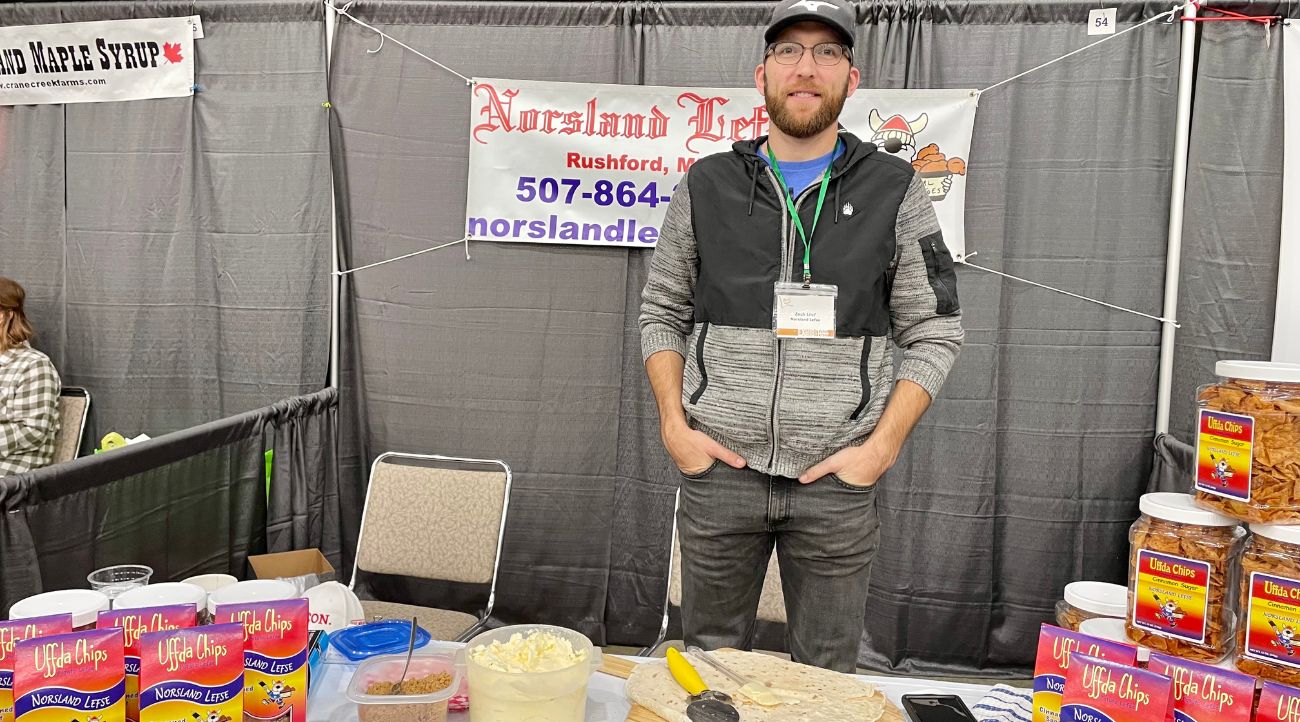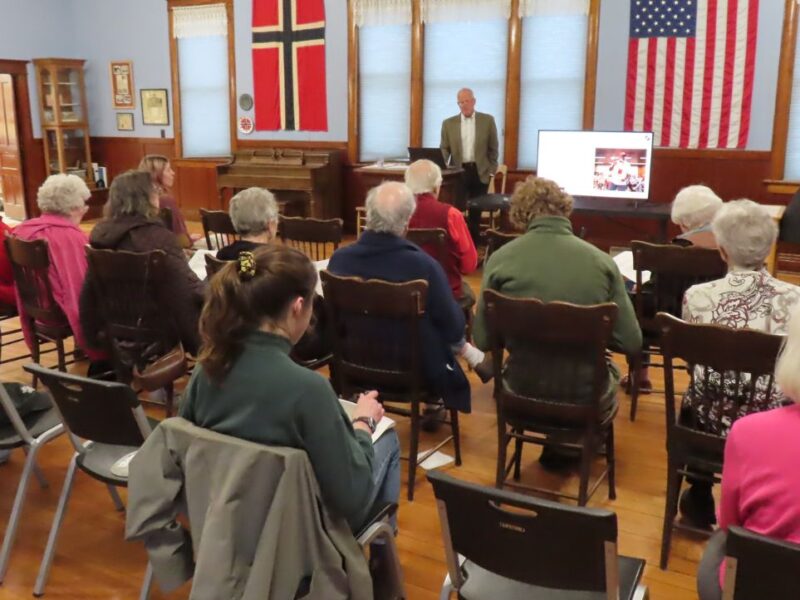Zach Lind, General Manager of Norsland Lefse, mans the company booth at the 2024 FEAST! Festival in Rochester. (Photo by Tom Brudvig)
Norsland Makes Lefse “Like Grandma Used To Make”
New owners look to expand to meet lefse demand
RUSHFORD – I have always been a bit skeptical of a “lefse factory” since all of my lefse experiences came from my grandmother, mother and church basement ladies who labored for hours by hand over the holidays to make this Scandinavian specialty. I was taught that “lefse” cannot be too thick, it must be “rolled out just right and flipped over at the proper time.” How could a factory produce such a unique and special “homemade” product?
I now know that progress does not always negatively impact quality, especially at Norsland Lefse in Rushford, just a few blocks from the Root River. I was very impressed with the thinness, texture and flavor of the Norsland product. The success of Norsland did not happen overnight.
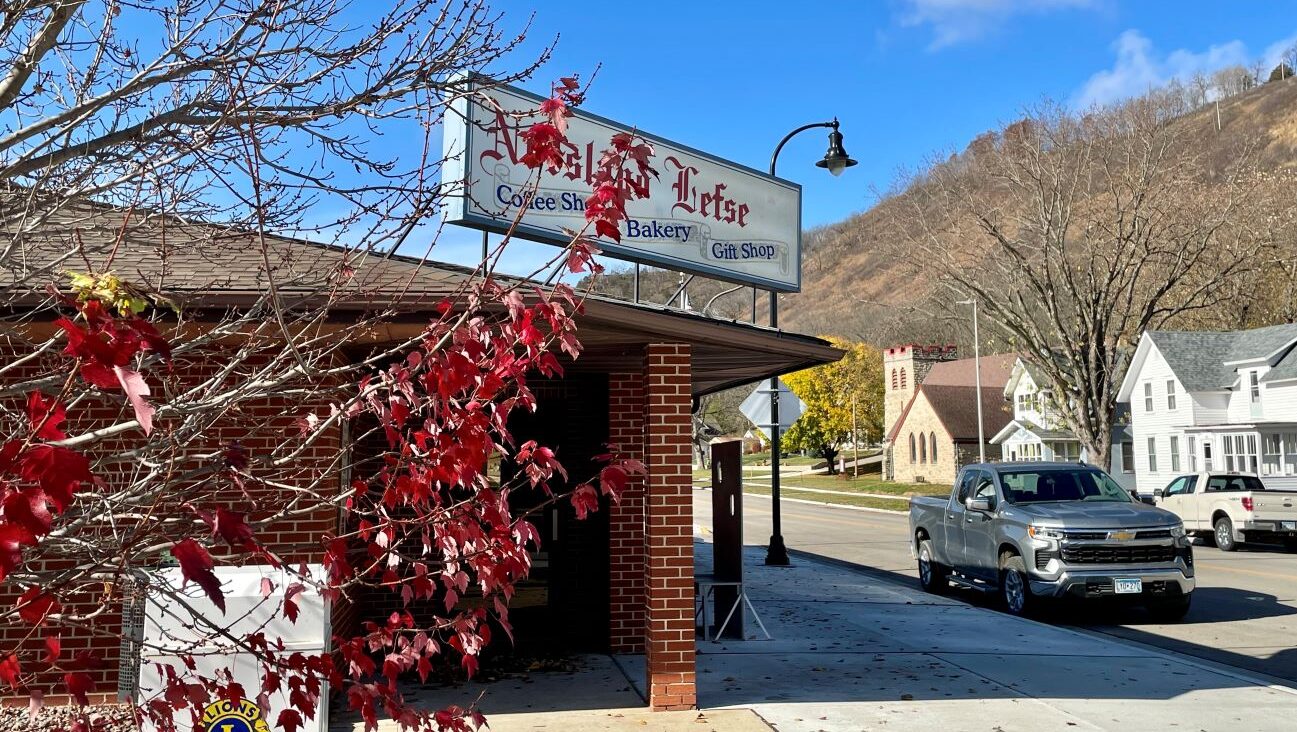
Norsland was started in Harmony in the early 70s and moved to Rushford in 1983. Following the flood of 2007, the store was moved to the old Tri-County Electric building. (Photo by Tom Brudvig)
Simple Beginnings in Harmony
Back in the early 1970’s Merlin Hoiness and his wife, Zola, were in the grocery business in Harmony, Minn. During those early days, according to their son, Jim, their love of lefse also translated into lefse making classes.
Most of the lefse “sales” were local to family and friends, but Merlin managed to sneak a supply of lefse to select grocery stores in Rochester and a batch or two to customers such as Tim Penny, former United States House of Representatives member, and now a regular supporter of business as the President of Southern Minnesota Initiative Foundation (SMIF).
The Hoiness’ recipe was based on the concept of fresh russet potatoes, flour, salt and oil with no preservatives. I was informed the secret is to use a dry (meaning russet) potato. This recipe carries over to today.
In 1983 Merlin and Zola moved the enterprise to Rushford and named it Norsland Lefse. The business thrived due to unprecedented demand for lefse.
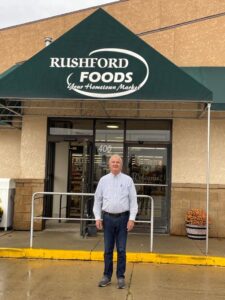
Jim Hoiness, son of Norsland founders Merlin and Zola Hoiness and a current owner of Rushford Foods, says Norsland started with lefse making classes from his parents’ home in Harmony.
The family operated Norsland out of a vacant bakery building until 1997 when they sold the business to local residents, Mark and Carolyn Johnson and Scott and Christi James. The early 2000’s saw Norsland move into online sales causing demand to double, with production during the Thanksgiving and Christmas season topping out at 1200-1800 rounds of lefse per day.
Historic Flood
In 2007 the business was flooded by Rush Creek. This event caused Norsland to find a new location across the alley in the abandoned Tri-County Electric offices.
The factory increased its size 5-fold and allowed an expansion to include a café, novelty items, Scandinavian cookies and sweets, cookware, private label jams, pickles, salsa, lefse chips and other Scandinavian foods.
In February of 2024 Norsland was sold to Lori and David McDonald, e-commerce specialists who noticed that 60 percent of sales were online. They believed that their expertise could help grow Norsland.
The McDonalds have now developed a new e-commerce platform for their online marketing which they hope will spur growth. Simultaneously, they hope to expand their wholesale accounts to get into more markets.
The challenge is to produce enough lefse to meet demand and get their lefse out to customers while fresh, when it is at its best. However, their lefse can be frozen and will be good several months after purchase.
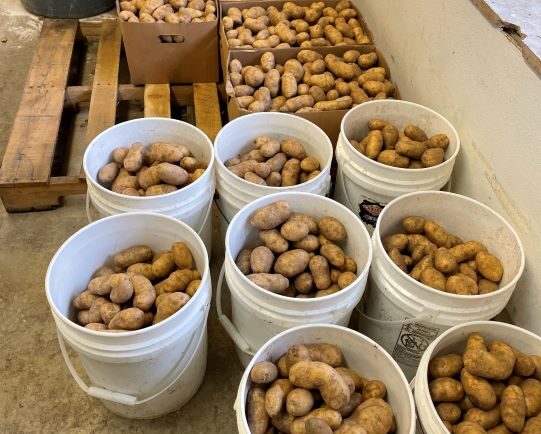
The secret to quality lefse begins with Russet potatoes. (Photo by Tom Brudvig)
Multi-Step Process
What are the details of lefse making? Zach Lind, the General Manager at Norsland since the McDonalds acquired the company, says it all starts by peeling potatoes in a rotary peeler. Then the potatoes are cooked in a jacketed steam kettle followed by ricing in a food mill.
The riced potatoes are mixed with flour, salt and oil in a dough mixer and formed into 10-inch disks using a dough sheeter. The 10-inch disks are stretched to 16 inches with very loud mechanical custom rolling pin machines invented by Merlin Hoiness and his friend Wilbur Peterson, and finally cooked on large flat top griddles.
Zach says that despite all the equipment, manual labor is essential in the process. The potatoes are loaded by hand into the peeler, transferred to the cooker and milled. The dough is moved between every station using lefse sticks.
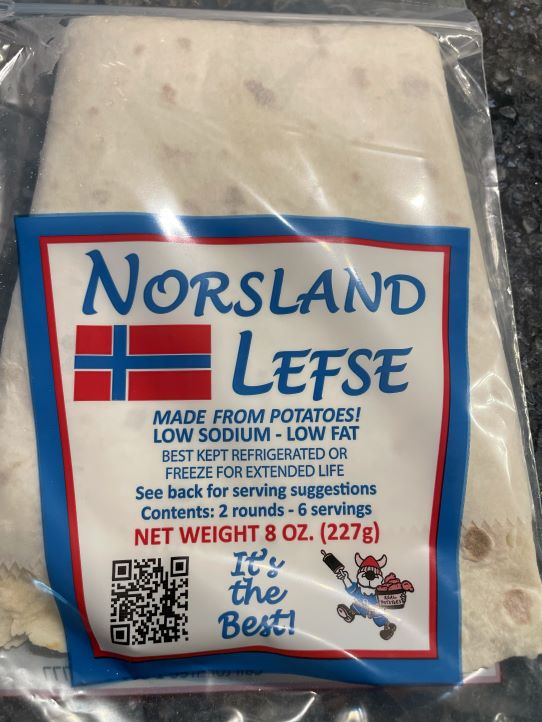
Fresh lefse ready to be shipped to markets around the country. Sixty percent of sales are online. (Photo by Tom Brudvig)The product is then cooled, folded and packaged by hand for shipping and sales. The equipment, in total, consists of one peeler, two jacketed steam kettles, one dough mixer, one dough sheeter, nine rolling pin machines and five griddles. (Photo by Tom Brudvig)
About 400 pounds of lefse are produced each day, with demand exceeding supply. Norsland, historically, has not been open during the summer months, thereby limiting production due to the lack of air conditioning in the building. That restriction is likely to change soon along with the addition of new machines that will shape and press the dough.
For now, Merlin’s original rolling pin machines are banging along, saving human wrists, elbows and shoulders from wearing out.

Merlin Hoiness and his friend Wilbur Peterson created a mechanical rolling pin machine that stretches the lefse dough from 10-inch disks to 16 inches. The machine is still in use today. (Photo by Tom Brudvig)
I am not sure where I heard this, but it could have come from Jim Hoiness, Merlin’s son, or perhaps from a Scandinavian at the Lanesboro Museum. One of them informed me that lefse should only be eaten with butter and sugar and that if anyone deviated from that combination there was either something “wrong” with them or their Scandinavian heritage was not “pure”.
I don’t think you can go wrong with butter and sugar, except if you find yourself eating lefse while writing a story over your keyboard.
…………………
 Contributor
Contributor
Tom Brudvig lives in Lanesboro and is active in the community as a volunteer for the Rhubarb Festival, Buffalo Bill Days and Lanesboro Arts.


